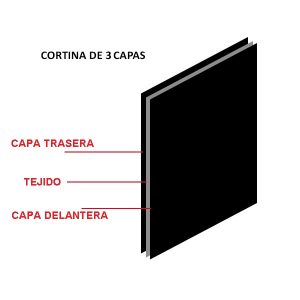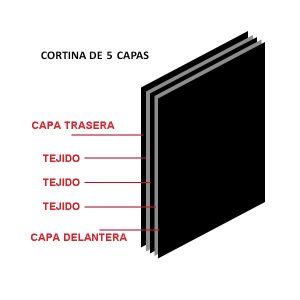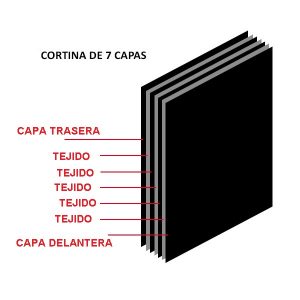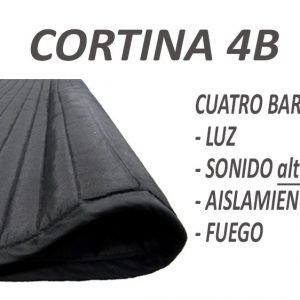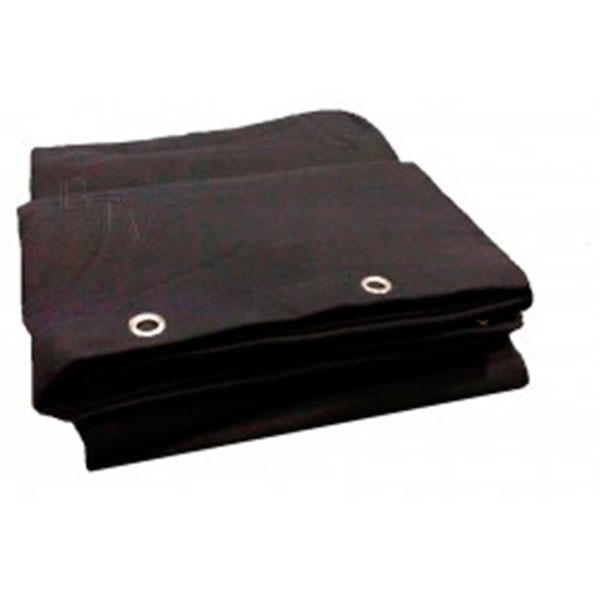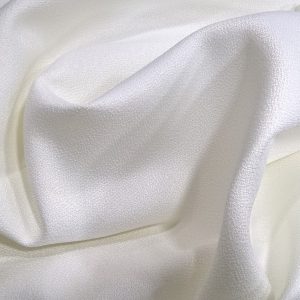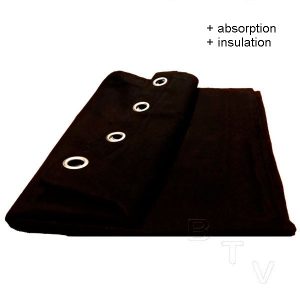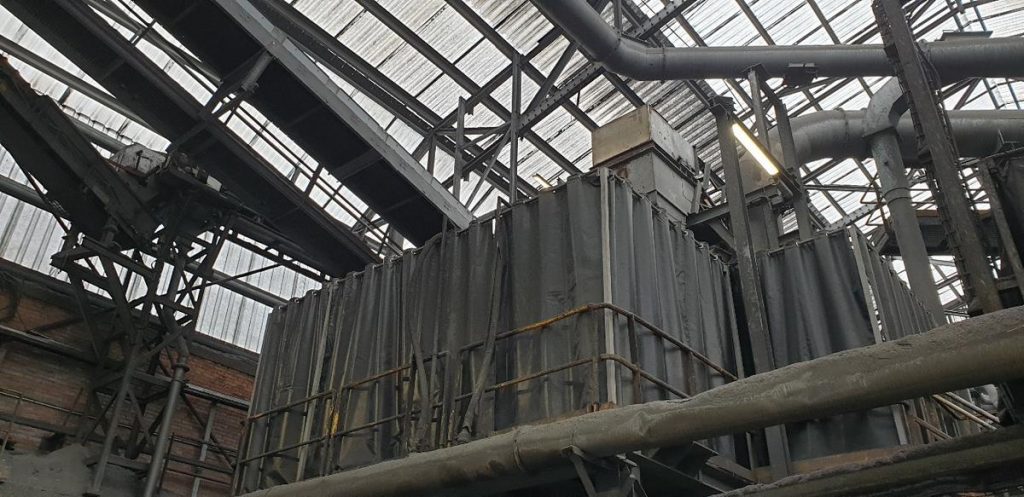Acoustic fabrics allow to improve the acoustic comfort of enclosures offering a wide range of acoustic solutions in both acoustic insulation and conditioning. Acoustic fabrics can be used in a multitude of enclosures such as theatres, private homes, restaurants, shops or studios.
In addition, acoustic fabrics offer numerous advantages. Some of them are:
WHICH FABRIC DO I NEED?
ACOUSTIC SOLUTIONS: ACOUSTIC INSULATION AND CONDITIONING
In general, we can divide problems generated by excessive noise into two main groups.
Problems due to noise generated inside the venue: in its normal activity, reverberation is generated inside the venue, creating a feeling of noise that makes it difficult to hold conversations -common in restaurants, studios, minimalist venues, etc.
-
Molton Sella Acoustic Curtain 300g 295 x 300 cm
- 115,68€ Sin IVA
-
Alpha BTV – Acoustic Fabric
- Desde 23,20€
In TEXTIL BATAVIA we have ACOUSTIC FABRICS for both acoustic insulation and acoustic conditioning solutions. All our products have been tested by specialized laboratories to certify their acoustic quality.
CASE STUDIES
Our acoustic engineers have advised our customers on numerous projects in the field of acoustics. Here are some of them, as a sample of the multiple actions that can be carried out with our fabrics.
More about acoustic insulation and acoustic conditioning
Which fabric do I need?
To choose which fabric best suits your needs, the first step is to identify your circumstances.
If the enclosure or room where you want to place the fabric presents any of these problems:
– Noise from neighbours walking around -children running, heels, etc.
– Noise from neighbours’ cisterns.
– Noise from the premises located in the commercial ground of the building – bars, pubs, cafes, etc-.
– Noise from the terrace of a bar.
– Noise from an air-conditioning unit in another dwelling.
– Noise from traffic.
– Noise from a mechanical garage door.
– Noise from the building’s lift
– Noise from the neighbour’s TV.
Then you need a fabric suitable for acoustic insulation. For further information about acoustic insulation, please see our frequently asked questions about acoustic insulation.
On the other hand, if the room where you want to place the fabric produces noise at the slightest activity, whether it is listening to music, watching television, playing a musical instrument or even having conversations, then you need a fabric suitable for acoustic conditioning. For further information about acoustic conditioning, please see our frequently asked questions about acoustic conditioning.
However, if you have any doubts, do not hesitate to contact us and any of our acoustic engineers will guide you without any obligation.
What do the acoustic conditioning parameters in the catalogue mean?
What is the absorption coefficient?
What is the absorption coefficient for?
What is reverberation?
These problems are quite common and are not only limited to venues of restaurant industry, but can also appear in all types of venues with reflective surfaces -mirrors, glass, polished floors and walls, etc.- or with open spaces inside -minimalist architecture-.
These rooms have problems due to excessive reverberation.
Why is reverberation generated in a room?
When the propagated sound waves find a surface, a double phenomenon occurs: a fraction of the sound waves is absorbed inside the wall and the rest is reflected.
Depending on the degree to which the walls absorb the sound waves, we can speak of absorbent or reflective materials. Absorbent materials are those that absorb most of the sound waves that hit their surface. Reflective materials, on the other hand, absorb little of the sound waves. If an enclosure is made of reflective materials – glass, mirrors, polished surfaces – the sound waves generated inside the enclosure will be reflected excessively, producing reverberation: at the slightest activity inside the enclosure, a sensation of amplified sound will be generated, like the bustle generated by diners in a bar.
How is the reverberation of a room measured?
What is the relationship between the reverberation time of a room and the absorption coefficient?
Knowing the absorption of materials is therefore the first step to control the reverberation of a room.
How is the absorption coefficient of a material obtained?
The absorption coefficient tests of this norm are carried out in standardised reverberation chambers. These chambers are closed rooms with high reverberation – reverberation times greater than 10 seconds – in which the reverberation time of the empty room is first measured using an omnidirectional loudspeaker to emit the noise and, subsequently, a measurement of the reverberation time is made with the curtains installed inside the room. From the results of both situations, the curtain absorption coefficient – the noise absorbed by the curtains – is obtained.
In additin, to ensure that the measurements are reliable, the curtains tested must be between 10 and 12 m2 in size.
How do I interpret the catalogue parameters?
1-Frequency absorption coefficient values:
What is frequency?
If we take a musical instrument, for example, a guitar, when one of its strings is plucked, it produces a sound -a musical note-. To produce the musical note, the plucked string vibrates around its initial position. Frequency is measured in Hertz (Hz) and is defined as the number of times per second the string vibrates. Thus, when you tune your guitar, you are adjusting the tension of the string so that it vibrates at the desired frequency when si plucked. For example, the note A is tuned to 440Hz, so that each time the note is plucked, the string that generates it vibrates at a rate of 440 times per second.
As sounds are made up of frequencies and the human ear does not perceive all frequencies in the same way, the ISO 354 standard -and in general all standards related to acoustic conditioning- establishes the frequencies at which the results should be presented, as these are considered the most representative.
These frequencies are 125, 250, 500, 500, 1000, 2000 and 4000Hz. For each of these frequencies, the average value of the absorption coefficient obtained from the averaging of the frequencies adjacent to them is given. At the frequency of 4000Hz, for example, the tested acoustic curtain has an absorption coefficient of 0.76. This means that for all sound waves with a frequency of 4000Hz, the acoustic curtain will absorb 76% of them.
2-Weighted values of absorption coefficient:
The second table indicates different parameters of the weighted absorption coefficient. In other words, the absorption coefficient of these parameters is obtained by averaging the absorption coefficient of various frequencies. The differences in the results of these parameters are due to the frequencies chosen for averaging.
The parameter αmid is not obtained by averaging, but by comparing the values obtained with reference values. The calculations are too complex to be given in this catalogue. However, the results are often similar to those of the αw parameter. These two parameters are the most commonly used in room acoustics as they are considered to be the most representative.
What do the sound insulation parameters in the catalogue mean?
Both the graph on the left and the tables provide information on the level of acoustic insulation of the curtain.
What is acoustic insulation?
– Noise produced by neighbours walking around -children running, heels, etc.-
– Noise from neighbours’ cisterns.
– Noise from premises located on the commercial ground floor of the building -bars, pubs, cafés, etc.-.
– Noise from the terrace of a bar.
– Noise from an air conditioning unit in another dwelling.
– Noise from traffic.
– Noise from the mechanical door of a garage.
– Noise from the building’s lift.
– Noise from the neighbour’s television.
– Noise from the neighbour’s television.
And many more.
These problems are not exclusive to private homes, but also occur in other environments that we frequent regularly, such as the workplace.
Acoustic insulation can be defined as the set of acoustic solutions that are used in rooms that have problems such as those described above. These solutions range from construction elements – walls and floors made with acoustic insulation – to other technical elements such as acoustic curtains and their objective is to prevent noise from outside from filtering into a room.
How is sound insulation measured?
What is the noise reduction index for?
How is the sound reduction index obtained?
The acoustic reduction index tests of this standard are carried out in standardised transmission chambers. These chambers are composed of two adjoining enclosures separated only by a partition surface where the sample to be tested is placed. For the test, noise is emitted in an omnidirectional loudspeaker in one of the enclosures (transmitting enclosure) and measurements are made of the noise reaching the other enclosure (receiving enclosure). From the difference between the noise emitted and the noise received at the receiver, the noise level that the material under test is capable of reducing is obtained.
How do I interpret the catalogue parameters?
1-Value of the acoustic reduction index by frequencies R:
What is frequency?
If we take a musical instrument, for example, a guitar, when we pluck one of its strings, it produces a sound -a musical note-. To produce the musical note, the plucked string vibrates around its initial position. Frequency is measured in Hertz (Hz) and is defined as the number of times per second the string vibrates. Thus, when you tune your guitar, you are adjusting the tension of the string so that it vibrates at the desired frequency when plucked. For example, the note A is tuned to 440Hz, so that each time this note is plucked, the string that generates it vibrates at a rate of 440 times per second.
As sounds are made up of frequencies and the human ear does not perceive all frequencies in the same way, the ISO 10140-2 standard – and in general all standards related to acoustic insulation – establishes the frequencies at which the results should be presented, as they are considered to be the most representative. These frequencies are 100, 125, 160, 200, 250, 250, 315, 400, 500, 630, 800, 1000, 1250, 1600, 2000, 2500, 3150Hz. For each of these frequencies, the averaged value of the acoustic reduction index obtained from the averaging of the frequencies adjacent to them is given. At the 2500Hz frequency, for example, the tested acoustic curtain has a sound insulation index of 20.7dB. This means that for all sound waves with a frequency of 4000Hz, the acoustic curtain will reduce the sound pressure generated by them by 20.7dB
2-Global Rw value
This is the global value in decibels obtained from the values of the acoustic reduction index by frequencies explained in the previous section.
What is a decibel (dB)?
The decibel is a unit of measurement widely used in telecommunications to express quantities of other units on a logarithmic scale. Thus, the word decibel can refer to several concepts. In the field of acoustics, decibels are used to measure both sound pressure and sound power.
To better understand what decibels are, let’s look at the following example:
Sound can be broadly defined as the physical phenomenon that occurs when an emitting body vibrates in a medium. When we speak, for example, our vocal cords vibrate, generating a sound wave.
As our vocal cords are in contact with the air – the medium – the wave generated creates pressure variations in the air, causing the particles that form it to vibrate. Thus, the air particles oscillate around their normal position, transmit the vibration to their neighbouring particles and then return to their initial position. In this way the sound wave propagates through the air particles at a speed that depends on the density and elasticity of the medium – approximately 340m/s in air.
When the wave reaches the receiver, it enters the ear and impacts with the eardrum membrane. The impact of the wave is received in the form of a nerve stimulus that the brain decodes as sound.
The discomfort that these sound waves cause us is equated with the pressure they exert on the membrane of our ears and corresponds to what is colloquially known as the volume at which they are heard. The volume, therefore, can be equated with the pressure that the sound waves exert on the medium.
Sound level meters are used to normalise and measure sound pressure, the operation of which is inspired by that of the human ear. A sound level meter contains a microphone made up of a membrane that receives the pressure that sound waves exert on its surface when they hit it. From a transducer, the value of the pressure exerted is obtained.
Sound pressure is measured in Pascal (P), after Pascal. However, in practice, the measurement in Pascals is converted to a logarithmic scale to normalise its value and is called sound pressure level, measured in decibels.
To normalise the decibel value, the following formula is used:
Lp = 20xlog (P / Pref)
Where Lp is the sound pressure level, i.e. the pressure value measured in decibels.
P is the pressure realised by the sound wave.
Pref is the reference value by which the measured sound pressure is normalised. It has a constant value of 2×10-5P.
Observing the expression we see that it contains units of pressure in both the numerator and the denominator, the result being dimensionless. Therefore, the result is only expressed in dB (decibels) and not in decibels Pascal (dBP). In other fields of telecommunications, units of dB (decibels) are used.
The reason for this standardisation is simple: since the decibel is only a unit of measurement that depends on another unit (in this case sound pressure), it was possible to establish a value to be used as a reference.
This is better understood if we look at it mathematically: if we take a sound wave that exerts a pressure on the membrane of our ears -or on the membrane of a loudspeaker- of 2×10-5P, applying the formula and the properties of logarithms, we will obtain the value of 0 decibels.
Thus, the value of 2×10-5P becomes the reference value in the new decibel scale. If we take any lower value, the result will be negative. And if we do the same with any higher value, the results will be positive.
The value of 2×10-5P is used as a reference because it corresponds to the threshold of human hearing. In other words, sounds that exert pressures on the membranes of our ears below this value are not perceived by our ears – colloquially put: the lowest volume we can hear. Thus, when converted to decibels, the values obtained greater than 0 correspond to the pressures that are perceptible to the human ear. As mentioned above, sound level meters have been developed inspired by the human ear. Therefore, the electronic circuits of sound level meters do not register pressures lower than the reference pressure either, so that in practice the dB values will always be higher than 0dB and therefore any dB value will always be a value perceptible to the human ear.
The sound pressure level representing the pain threshold is approximately 135-140dB.
Why are dBs used?
dB is used for two main reasons. The first is that, as explained in detail in the previous section, it allows us to normalise the pressure values so that we only have values of pressures that we can perceive. In addition, the logarithmic scale makes its assimilation easier. For example: If we take the value of the minimum threshold – the aforementioned 2×10-5P, corresponding to 0dB – and place the maximum at around 140dB, whose pressure is around 200P, we will have a too large range of numbers of pressure in Pascals. That is, the range of pressure values in Pascals is vast, making it unintuitive. Another example: if we have a sound wave that has a pressure of 2×10-3P, it is intuitively more difficult to establish whether it is a large or small value than if we compare it to its value in dB, which is 60dB.
The second reason why dB is used is related to human perception. Our auditory system does not respond in a linear way to sound stimuli. When our ear hears a pure tone of a certain sound pressure, if this pressure is doubled, the subjective perception does not interpret that the loudness has doubled, but subjectively perceives an increase of a lesser degree. In this way, the perception of the ear is better related to the values of the logarithmic scale.


